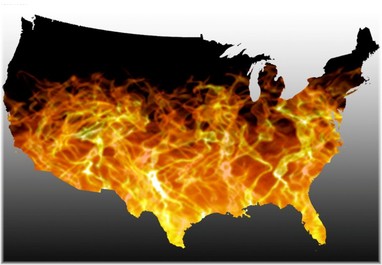“Today’s plunging commodity prices represent something new under the sun. That is, they are the product of a fracturing monetary supernova that was a unique and never before experienced aberration caused by the 1990s rise, and then the subsequent lunatic expansion after the 2008 crisis, of a cancerous regime of Keynesian central banking,” states Miles Franklin.
He’s not the only one who thinks lower oil prices mean trouble.
In a recent interview, DoubleLine’s Jeff Gundlach explained his concerns about the oil market not being “unequivocally good” for everyone…
Question: The crash in the oil market is already causing jitters in the financial markets around the globe. What is your take on that?
Gundlach: Oil is incredibly important right now. If oil falls to around $40 a barrel then I think the yield on ten year treasury note is going to 1%. I hope it does not go to $40 because then something is very, very wrong with the world, not just the economy. The geopolitical consequences could be – to put it bluntly – terrifying.
What would that mean for stocks?
There Will Be No Rebound in Oil Prices
“Most of the world is at “peak debt”. That is, the ratio of total credit market debt to current national income ranges between 350% and 500% in every major economy;
and that is the limit of what can be serviced even at today’s aberrantly low interest rates.”
US Rig Count Continues To Plunge To 10-Month Lows
Just as T.Boone Pickens warned, watching the US Rig Count is key to comprehending the looming crisis in oil. The last 4 weeks alone have seen a drop of over 100 rigs – the 2nd fastest slide since 2001 in percentage terms. This is the worst December to January since 2008/9. As Pickens noted, “demand is down” – “lower demand is the main driver” – “rig count is gonna fall – drop 500 rigs in next 6-9 months”.
Miles Franklin adds, “Fed and other Central banks’ relentless monetary bubbles created such massive overcapacity in commodity production, it could take years – or decades – to be worked through. In other words, for all intents and purposes, the current plunge in commodity prices will be permanent.Nearly certainly in real terms, and possibly nominal terms as well – unless/until the Central banks inevitably resort to hyperinflation to “repay” their debts; which sadly, has been the route taken in every fiat regime throughout history.
Thus, particularly given my ten years of experience as a Wall Street energy analyst, I am incredulous when I hear people speak of the “temporary” nature of the oil/commodity price decline; such as, for instance, Janet Yellen, who earlier this month described it as “transitory” – although clearly, she was lying through her teeth.
No, the multi-million barrel/day difference between supply and demand will decidedly NOT “correct” itself; particularly as demand continues to plunge, and supply to surge. You see, unlike in 2008, Central banks cannot inflate the money supply without causing hyperinflation, and manufacturing capacity is dramatically larger, financed predominantly with high-yield debt from an insolvent banking system.
Saudi Arabia itself just announced a record trade deficit; and given that it, and most OPEC producers, are socialized nations relying on $100 oil to fund spending programs, there is essentially no chance they will cut production; as not only do they desperately need the revenues, but are low-cost producers; and thus, know they can destroy high-cost producers, such as the U.S. shale industry. And sadly, this argument is not limited strictly to oil, but countless other resource-exploiting industries.
Except, of course, gold and silver – which are not only the polar opposite of “commodities” (given their maximum utility during times of financial crisis), but have been “treated to” the polar opposite supply effect of other commodities.
In other words, just as the Central banks funneled endless amounts of printed money into the production of industrial commodities,
their unrelenting suppression of gold, silver, and mining shares has created an essentially guaranteed production collapse; again, which could take decades to resolve,
with the double whammy of occurring amidst historic demand.
At the Miles Franklin Blog, we have written of this all year; and given my five years’ experience in the mining industry, I can tell you unequivocally that this outcome was set in stone as far back as 2011, when the industry was already devastated by capital strangulation, surging production costs, and surging geopolitical risks.
In October we concluded that a 50% silver production decline in the coming years is not unrealistic; and as for gold, it too will unquestionably experience dramatic production declines in the coming years, as essentially no material capacity is expected to offset unrelenting depletion, particularly in today’s suppressed price environment.
Of course, when prices do inevitably explode, it will no doubt be due to the Cartel finally losing control over financial markets. This, in turn, will cause an historic “gold rush,” not just by investors but governments themselves – such as, for example, “repatriators” like Germany, Holland, and Austria. Not to mention the “pink elephant” in the room – CHINA.
We can only warn you of the likelihood that 2015 may be the ugliest economically of our lifetimes; during which, the few assets one can PROTECT themselves with likely trade at huge premiums to today’s levels; that is, if you can find them at all.”
Article authored by Carol Serpa. You can find the original story right here.


